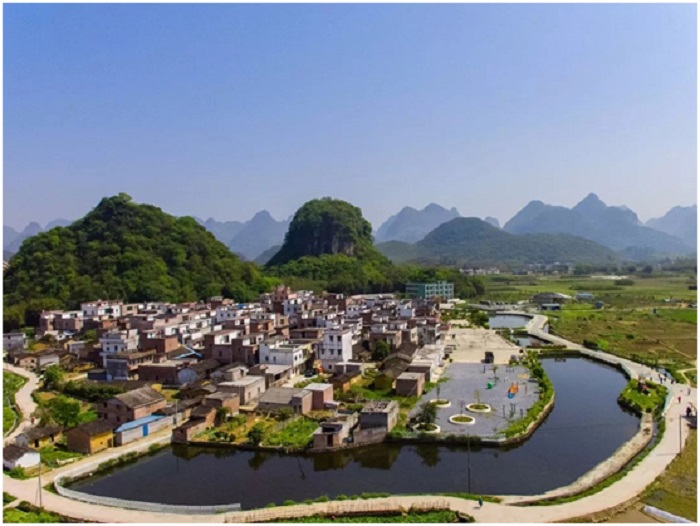



Qingyuan, South China’s Guangdong Province, has been solving the urban and rural divide by pursuing integrated development between urban and rural areas.
By developing rural tourism, Qingyuan has not only satisfied the needs of urban residents, but facilitated rural development.
With about one hour’s drive, citizens in the province’s capital city Guangzhou could embrace lucid waters and lush mountains in the mountainous areas in northern Guangdong’s Qingyuan. Meanwhile, villagers could shake off poverty and live a better-off life through rural tourism.
One of the gaps between urban and rural areas is the positioning accuracy of mobile navigation software, which usually provides higher accuracy and better-planned navigation routes in large cities than in rural areas. However, the navigation software could plan quite accurate routes on the rural roads in Qingyuan.
The accurate routes and timing information demonstrate the continuous improvements in navigation technology and the popularity of the trip to the local villages.
The villages will improve road signs at intersections and mark them on e-maps to make navigation more accurate and convenient for more tourists traveling by car, said the local residents.
The slogans of solving the urban and rural divide have been put up in Qingyuan’s urban and rural areas. According to Wu Cankai, Party chief of Xinqiao village, Qingcheng district of Qingyuan, addressing the problem of better development calls for travel and consumption in villages by more urban residents, which is an important measure to shake off poverty and the key to realizing integrated urban-rural development.
To realize the goal, Xinqiao has continuously tapped into local tourism resources to attract visitors in recent years. It has also worked together with some well-known enterprises to create a development model integrating planting, harvesting fruits and vegetables, tourism and B&Bs, building the village with more thriving businesses and prosperity, as well as better facilities and tourism experience for the visitors. In the eyes of the villagers, the village is as neat as urban residential compounds.
To change the urban-rural dual structure and address the imbalanced development between urban and rural areas, efforts should be made to ensure that villagers are willing to stay.
In the past, many villagers chose to work in mega cities away from their families to earn money. Nowadays, more and more villagers decide to work near home.
“Streetlamps have been installed and our village is equipped with bus service, so it’s more convenient for us to travel and for our children to go to school,” said a resident in the city’s Lianzhang village.
To residents in the village, streetlamps and buses, which could only be seen in cities in the past, are important indicators of a better-off life.
Besides, the village has established poverty alleviation workshops and an agricultural technology demonstration park, which allow villagers to earn as much as migrant workers in cities. Working in the city or staying in the village is no longer a difficult choice for them as it used to be.
In addition to cutting the gap in income between urban and rural residents, Qingyuan has also tried to improve the skills and change the ideas of the villagers, including the internet-based thinking and new media literacy of the local officials and residents.
Liu Fengming, an official in the city’s Shuixi village, talked about livestream in a clear and logical manner and was very adept at using new media.
Internet platforms have expanded sales channels for local specialty products. To help the impoverished people acquire e-commerce skills, the local government has rolled out a free professional training program.
Facts have proved that farmers in their 50s and 60s can also master e-commerce skills if they are provided with sufficient incentives and correct guidance.
To solve the problem of uneven development between the urban and rural areas and to integrate agricultural development with modern markets require cultivating such a new type of modern-thinking farmers with modern technology.
An intercity railway connecting Guangzhou and Qingyuan is expected to start operation by the end of October. By then, it will take only 25 minutes from Guangzhou North Railway Station to Qingyuan.
As the barriers between urban and rural areas are further removed, the northern Guangdong and the Guangdong-Hong Kong-Macao Greater Bay Area will continue with integration and the province will pursue more balanced development between urban and rural areas and among different regions.


The Humanitarian Service Diamond Awards has.
A Chinese Company, Inner Galaxy Steel.


The Programme Coordinator, Regulatory, Compliance and.


A Non-Governmental Organization (NGO), Committee for.
The Trustfund Pensions Limited has chided.


The House of Representatives Committee on.
The China General Chamber of Commerce.


Senator Chuka Utazi who represented Enugu.


An Abuja based Legal Practitioner, Ugochukwu.


The African business community in Yiwu,.
Leave a Comment